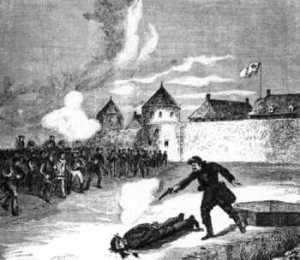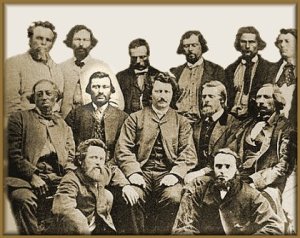A few weeks back, a MoC reader sent me a series of messages as part of a diatribe against all things bilingual in Canada. She saw conspiracy everywhere and was not hesitant to tell me that I was blind to facts, as she saw them. Considering that she does not know me from Adam and I can say that I have never, as far as I know, met this person; she sure got on my case. One of the things she included in her package was a newspaper clipping from the New York Times dated: April 11, 1974. The article was entitled:
THE SCOTT MURDER – The trial for which Louis Riel was denounced.
THE HELPLESS AND WOUNDED VICTIM (Thomas Scott) NAILED UP ALIVE IN HIS COFFIN FOR TEN AND A HALF HOURS, AND THEN KILLED BY A BRUTAL MAN.
This was the story of the alleged final hours of Orangeman Thomas Scott, who was charged with treason for attempting, with others, to overthrow Louis Riel’s Provisional Government. He was found guilty in a democratic trial and executed by firing squad. It was for this “crime” that Louis Riel was eventual hanged.
NOTE: Let’s get one thing absolutely straight! Louis Riel was charged with treason by the Orange-leaning Government of Canada but he was hanged, following what has been described as a less-that-democratic trial, on November 16, 1885, for the death of Orangeman Thomas Scott!
But let’s turn to the clipping. It was originally a letter from John Bruce, the President of the Métis Nation. The Métis Nation formed the Provisional Government that was formed to protect and secure the Métis and Indians left desperate when the Hudson’s Bay Company Governor, William McTavish, pulled out of managing strategic areas of the west.
John Bruce (Jean Brousse) sits to the right of Louis Riel
In his alleged letter to the Ottawa Free Press, he described the execution of Scott as a very brutal event.

“On the 4th of March, 1870, Thomas Scott was shot opposite the fort, a little below the road leading to the Assiniboine River, after a sham trial, passed in the absence of him that was doomed to death. M. Riel says, “On the third of the same month (March) we brought Scott before a tribunal of war.” He was not brought before that tribunal of assassin* before his sentence of death was passed, and be was brought thither, not to plead his cause, but simply to hear the reading of the sentence already delivered against him.“Among the seven who formed the tribunal of war, one—only one—had the courage to oppose the sentence of death, denouncing it as a cold-blooded murder. The six others shamefully bent their heads before the petty tyrant’s will. Eternal shame is upon the heads of those six men. Their cowardice has written on their heads the word assassin, while the courage of the opponent makes today the consolation and happiness of his conscience. That man who fearlessly voted against the six others, in spite of the abusive language and threats, was Baptiste Lepine, Ambrose’s brother, who, with the five others, voted for Scott’s death. I said the execution took place on the 4th of March, 1870. The details of that butchery cause a human being to shudder with horror, and it is hard to conceive how it is that men’s hearts can contain such wickedness, can surpass in cold blooded cruelty of the most ferocious animals. Six soldiers had been chosen to shoot Scott. I have here again to write the name of a. man whose behavior in that circumstance reflects on him the greatest honor. Augustin Parisien, one of the six soldiers, declared openly that he would not shoot at Scott; and, in fact, he took off the cap from his gun before the word of command —“present”—was given. Of the five balls remaining only two hit the poor victim, one in the left shoulder, the other in the upper part of the chest above the heart. Had the other soldiers missed the mark unintentionally, or had they willingly aimed too high, too low, or to the side? It is unknown.

“However that may be, as the two wounds were not sufficient to cause death, at least sudden death, a man named Guillemette stepped forward and discharged the contents of a pistol close to Scott’s head while he was lying on the ground. This ball, however, took a wrong direction. It went into the upper part of the right cheek and came out somewhere about the cartilage of the nose. Scott was still not dead, but that did not prevent his executioners from placing him, alive and still breathing, in a kind of coffin made of four rough boards; it was nailed and placed in the south-east bastion, and an armed soldier was placed at the door. This would seem like a story made at one’s ease if there were not several witnesses full of life who beard between the hours of 5 and in the evening the unfortunate Scott speaking from under the lid of this coffin, and it is known that he had been shot at 12:30. What a long and horrible agony, and what a ferocious cruelty on the part of his butchers! The words heard and understood by the French Métis were only these: ‘ My God! My God! Some English Métis, and others speaking Scott’s tongue, heard distinctly these words, “For God’s sake, take me out of here or kill me!’ Toward 11 o’clock, that is after ten and a half hours of frightful agony, a person whose name I shall with hold for the present went into the bastion and gave him the finishing stroke with a butcher’s knife according to some; with a pistol according to others. That same person after having inflicted the last blow to poor Scott, said, as he was coming now from the bastion. “The son of a bitch shall not speak any more; he is dead this time. The corpse was left in the south-east bastion a few days, being watched by soldiers, relieved each in tarn. On the third or fourth night, I could not say precisely which.
“The corpse was taken out of the bastion, placed in Dr. Schultz’s sleigh, the same in which the doctor had brought to jail Mrs. Schultz, then sick, pulled the sleigh himself, as I have stated in my second letter. That same vehicle, now drawn by a gray horse, was taken toward the Red River and stopped about one and a-half miles from the fort, nearly opposite the River La Seine. By means of a large stone tied to the corpse, the body of Thomas Scott went to the bottom of the river to come thence no more. A few words more and I am through this horrible tragedy. It was in the afternoon of the day when the execution took place that the corpse was placed in the coffin; and it was later taken out of it in the bastion, but, in order to avoid suspicion, a grave had been dug inside the gate facing the Assiniboine River, a few steps to the right, and it was there the coffin which was thought to contain Scott’s body was lowered.”
So what do we make of this story. It certainly does not sound like the Riel or the Provisional Government that I know. I decided to investigate further.Turns out that Mr. Bruce may have had an axe to grind against Riel. On October 19, 1869, the National Committee of the Métis was formed at St. Norbert, Manitoba, with John Bruce as President and Louis Riel as Secretary. But is also seems that Bruce owed his title to Riel who was really the brains and the charisma behind the organization.
By December 23, 1869, Bruce had resigned as President and Riel took over. Certainly there was no allegiance by Bruce to Riel. But let us look at the rest of the story about the Bruce letter.
In 1869, Charles Boulton was part of a survey party sent to the Red River Settlement. On the orders of survey party leader, John Stoughton Dennis, he organized a group of volunteers to try to put down an uprising by Riel. Scott was one of his volunteers. When 50 of Boulton’s group were captured and imprisoned by Riel, he (Boulton) left the settlement and went to Portage la Prairie. Boulton met some people who had escaped from Riel and led an attempt to free the remaining captives. They were taken captive by Riel’s Métis. Boulton was later released and returned to Ontario. If Riel was so brutal, why was Boulton released unharmed?
In his recall of the events in the Red River, Memoirs of the North West Rebellions, Boulton cites Bruce’s letter. This is when the letter came to light. Bruce had not sent the letter to the Ottawa newspaper. The newspaper was reporting from Boulton’s book. The predominantly Orange population in Ontario hated Riel. And what better way to foment this hatred than to sensationalize the death of Scott.
I am not saying that is the way things went down back in 1870, but I am not so naive that I accept either Boulton nor Bruce’s accounts of the death of Scott at face value.

0x3537d76a
Very thought provoking. It does seem out of character for Riel to act outside of the freshly formed government’s authority. However at this time there were U.S. Soldiers cutting the breasts off of women and using them as a foot ball. So in the context of the situation I’d say that is the price of being a traitor to the newly formed government.